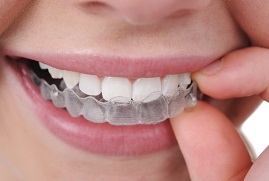What Are Clear Aligners?
Clear Aligners are straightforward plate made of exceptional material which are used to straighten teeth simply like braces. They use delicate and consistent power to move the teeth in the necessary situation without experiencing the issues of metal wires and sections. They are specially designed for every patient through a digital scan.
They are made for each individual and designed to move teeth in the ideal course very slowly. This is accomplished by carefully capturing impression and preparing the data using specific programming, where the future projections for better outcomes and straighter teeth are figured and afterward the processing machine naturally custom fabricates the arrangement of plate for you. All things considered, an individual needs around 25-40 sets for complete alignment.
Orthodontic is the Specialty which deals with the correction of crooked and maligned teeth and jaw bones. Its aim is to preserve the smile harmony through the correct alignment of teeth. The results of orthodontic treatment can be dramatic with beautiful smiles, improved dental health and an enhanced quality of life for many people of all ages.

Before & After Picture Gallery




Metal Braces/Traditional Braces
These are the metal brackets and wires, most recent brackets are smaller and less noticeable, new heat-activated curve wires utilize your body warmth to assist teeth with moving more rapidly and less painfully than before. These are most economical type colored bands allow children to convey what needs be.
Ceramic Braces
Ceramic braces are a similar size and shape as metal braces, then again, actually they have tooth-colored or clear sections that mix in to teeth. These are less observable than metal braces.
Lingual Braces/Invisible Braces
Lingual braces are the same as traditional metal braces, except that the brackets and wires are set up inside of teeth. Invisible braces are more complicated to clean and to adjust to, but as they're
Invisible Aligner
- Invisible Aligner consists of a progression of 18 to 30 uniquely made, mouth watch like clear plastic aligners. The aligners are removable and are removable at regular intervals.
- Practically Patients can eat and drink anything they desire
- These won't work for genuine dental issues; accessible for grown-ups and adolescents and not for kids.
Self-Ligating Braces
Self-ligating braces look very similar to the traditional fixed braces; however clips are used instead of elastic bands to hold the brace�s wire in place. This produces less friction and makes it convenient for you to brush around your brace and keep your teeth clean during your orthodontic treatment.
Types of orthodontic problems
- Over Crowding
- Deep overbite
- Open bite
- Overjet or upper protruding teeth
- Underbite or lower protuding jaw
- Crossbite
- Spaces in between teeth
Signs For Early Orthodontic Examinations
- Early or late loss of baby teeth
- Problem in chewing or biting
- Mouth breathing
- Crowding, Misplaced or blocked out teeth
- Jaws that shift or make sounds
- Biting the cheek or roof of the mouth
- Teeth that meet or bite abnormally or not at all
- Jaws and teeth that are out of ratio to the rest of the face
Benefits of Early Detection For Orthodontic Treatment
- Guide the growth of the jaw
- Regulate the width of the upper and lower dental arches
- Guide incoming permanent teeth into desired positions
- Lower risk of accidents to protruded upper incisors (front teeth)
- Correct harmful oral habits
- Reduce or eliminate abnormal swallowing or speech problems
- Improve personal appearance and self-esteem
- Potentially simplify and/or shorten treatment time for later corrective orthodontics
- Reduce likelihood of impacted permanent teeth
- Preserve or gain space for permanent teeth that are coming in
Frequently Asked Questions
Q.1. Why Do People Get Braces?
We for the most part recommend braces to improve a patient's facial appearance. Through orthodontic treatment, issues like abnormal or crowded teeth, overbites or underbites, inaccurate jaw position and disorder of the jaw joints are revised. Whenever left untreated, these issues can bring about tooth decay, gum illness, migraines and ear infections, just as speaking, biting or chewing problems.
Q.2. When is the right time for braces?
Patients with orthodontic issues can profit by treatment at almost any age. A perfect time for position of supports is between 10 to 14 years old, while the head and mouth are as yet developing and teeth are increasingly open to fixing. What's more, supports aren't only for kids. An ever increasing number of grown-ups are additionally wearing braces to address minor issues and to improve their smiles.
Q.3. What kind of braces will I have to wear?
After the starter test we would figure out what machine is best for your specific issue, however you regularly have a decision. The most well-known sort are sections, metal, clay or plastic, that are attached to teeth. Artistic sections are regularly clear or tooth-colored and are far less observable than metal brackets. Lingual, or covered, props are sections that join to the back of teeth, avoided see. The two kinds of supports use wires to move the teeth to the desired position.
Q.4. How long will I have to wear braces?
That relies upon your treatment plan. The more complicated your spacing or chewing problem is, and the older you are, the longer the period of treatment, usually. Most patients may need to wear full braces between 12 and 24 months, followed by the wearing of a retainer to set and align tissues surrounding straightened teeth.

